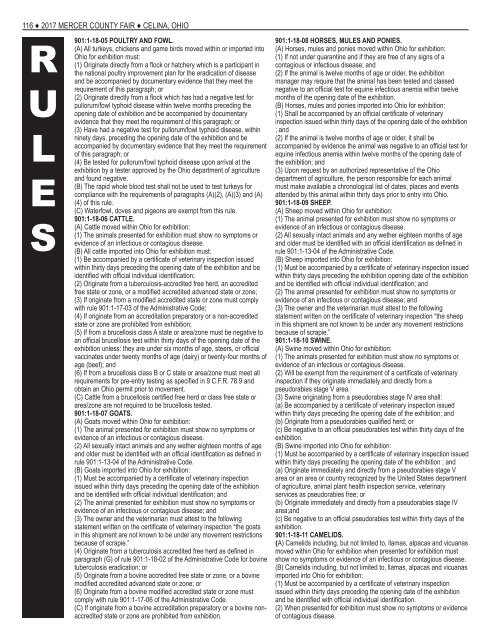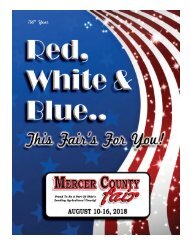2017-Mercer-County-Fairbook
Create successful ePaper yourself
Turn your PDF publications into a flip-book with our unique Google optimized e-Paper software.
116 ♦ <strong>2017</strong> MERCER COUNTY FAIR ♦ CELINA, OHIO<br />
R<br />
U<br />
L<br />
E<br />
S<br />
901:1-18-05 POULTRY AND FOWL.<br />
(A) All turkeys, chickens and game birds moved within or imported into<br />
Ohio for exhibition must:<br />
(1) Originate directly from a flock or hatchery which is a participant in<br />
the national poultry improvement plan for the eradication of disease<br />
and be accompanied by documentary evidence that they meet the<br />
requirement of this paragraph; or<br />
(2) Originate directly from a flock which has had a negative test for<br />
pullorum/fowl typhoid disease within twelve months preceding the<br />
opening date of exhibition and be accompanied by documentary<br />
evidence that they meet the requirement of this paragraph; or<br />
(3) Have had a negative test for pullorum/fowl typhoid disease, within<br />
ninety days, preceding the opening date of the exhibition and be<br />
accompanied by documentary evidence that they meet the requirement<br />
of this paragraph; or<br />
(4) Be tested for pullorum/fowl typhoid disease upon arrival at the<br />
exhibition by a tester approved by the Ohio department of agriculture<br />
and found negative.<br />
(B) The rapid whole blood test shall not be used to test turkeys for<br />
compliance with the requirements of paragraphs (A)(2), (A)(3) and (A)<br />
(4) of this rule.<br />
(C) Waterfowl, doves and pigeons are exempt from this rule.<br />
901:1-18-06 CATTLE.<br />
(A) Cattle moved within Ohio for exhibition:<br />
(1) The animals presented for exhibition must show no symptoms or<br />
evidence of an infectious or contagious disease.<br />
(B) All cattle imported into Ohio for exhibition must:<br />
(1) Be accompanied by a certificate of veterinary inspection issued<br />
within thirty days preceding the opening date of the exhibition and be<br />
identified with official individual identification;<br />
(2) Originate from a tuberculosis-accredited free herd, an accredited<br />
free state or zone, or a modified accredited advanced state or zone;<br />
(3) If originate from a modified accredited state or zone must comply<br />
with rule 901:1-17-03 of the Administrative Code;<br />
(4) If originate from an accreditation preparatory or a non-accredited<br />
state or zone are prohibited from exhibition;<br />
(5) If from a brucellosis class A state or area/zone must be negative to<br />
an official brucellosis test within thirty days of the opening date of the<br />
exhibition unless: they are under six months of age, steers, or official<br />
vaccinates under twenty months of age (dairy) or twenty-four months of<br />
age (beef); and<br />
(6) If from a brucellosis class B or C state or area/zone must meet all<br />
requirements for pre-entry testing as specified in 9 C.F.R. 78.9 and<br />
obtain an Ohio permit prior to movement.<br />
(C) Cattle from a brucellosis certified free herd or class free state or<br />
area/zone are not required to be brucellosis tested.<br />
901:1-18-07 GOATS.<br />
(A) Goats moved within Ohio for exhibition:<br />
(1) The animal presented for exhibition must show no symptoms or<br />
evidence of an infectious or contagious disease.<br />
(2) All sexually intact animals and any wether eighteen months of age<br />
and older must be identified with an official identification as defined in<br />
rule 901:1-13-04 of the Administrative Code.<br />
(B) Goats imported into Ohio for exhibition:<br />
(1) Must be accompanied by a certificate of veterinary inspection<br />
issued within thirty days preceding the opening date of the exhibition<br />
and be identified with official individual identification; and<br />
(2) The animal presented for exhibition must show no symptoms or<br />
evidence of an infectious or contagious disease; and<br />
(3) The owner and the veterinarian must attest to the following<br />
statement written on the certificate of veterinary inspection “the goats<br />
in this shipment are not known to be under any movement restrictions<br />
because of scrapie.”<br />
(4) Originate from a tuberculosis accredited free herd as defined in<br />
paragraph (G) of rule 901:1-18-02 of the Administrative Code for bovine<br />
tuberculosis eradication; or<br />
(5) Originate from a bovine accredited free state or zone, or a bovine<br />
modified accredited advanced state or zone; or<br />
(6) Originate from a bovine modified accredited state or zone must<br />
comply with rule 901:1-17-06 of the Administrative Code.<br />
(C) If originate from a bovine accreditation preparatory or a bovine nonaccredited<br />
state or zone are prohibited from exhibition.<br />
901:1-18-08 HORSES, MULES AND PONIES.<br />
(A) Horses, mules and ponies moved within Ohio for exhibition:<br />
(1) If not under quarantine and if they are free of any signs of a<br />
contagious or infectious disease; and<br />
(2) If the animal is twelve months of age or older, the exhibition<br />
manager may require that the animal has been tested and classed<br />
negative to an official test for equine infectious anemia within twelve<br />
months of the opening date of the exhibition.<br />
(B) Horses, mules and ponies imported into Ohio for exhibition:<br />
(1) Shall be accompanied by an official certificate of veterinary<br />
inspection issued within thirty days of the opening date of the exhibition<br />
; and<br />
(2) If the animal is twelve months of age or older, it shall be<br />
accompanied by evidence the animal was negative to an official test for<br />
equine infectious anemia within twelve months of the opening date of<br />
the exhibition; and<br />
(3) Upon request by an authorized representative of the Ohio<br />
department of agriculture, the person responsible for each animal<br />
must make available a chronological list of dates, places and events<br />
attended by this animal within thirty days prior to entry into Ohio.<br />
901:1-18-09 SHEEP.<br />
(A) Sheep moved within Ohio for exhibition:<br />
(1) The animal presented for exhibition must show no symptoms or<br />
evidence of an infectious or contagious disease.<br />
(2) All sexually intact animals and any wether eighteen months of age<br />
and older must be identified with an official identification as defined in<br />
rule 901:1-13-04 of the Administrative Code.<br />
(B) Sheep imported into Ohio for exhibition:<br />
(1) Must be accompanied by a certificate of veterinary inspection issued<br />
within thirty days preceding the exhibition opening date of the exhibition<br />
and be identified with official individual identification; and<br />
(2) The animal presented for exhibition must show no symptoms or<br />
evidence of an infectious or contagious disease; and<br />
(3) The owner and the veterinarian must attest to the following<br />
statement written on the certificate of veterinary inspection “the sheep<br />
in this shipment are not known to be under any movement restrictions<br />
because of scrapie.”<br />
901:1-18-10 SWINE.<br />
(A) Swine moved within Ohio for exhibition:<br />
(1) The animals presented for exhibition must show no symptoms or<br />
evidence of an infectious or contagious disease.<br />
(2) Will be exempt from the requirement of a certificate of veterinary<br />
inspection if they originate immediately and directly from a<br />
pseudorabies stage V area.<br />
(3) Swine originating from a pseudorabies stage IV area shall:<br />
(a) Be accompanied by a certificate of veterinary inspection issued<br />
within thirty days preceding the opening date of the exhibition; and<br />
(b) Originate from a pseudorabies qualified herd; or<br />
(c) Be negative to an official pseudorabies test within thirty days of the<br />
exhibition.<br />
(B) Swine imported into Ohio for exhibition:<br />
(1) Must be accompanied by a certificate of veterinary inspection issued<br />
within thirty days preceding the opening date of the exhibition ; and<br />
(a) Originate immediately and directly from a pseudorabies stage V<br />
area or an area or country recognized by the United States department<br />
of agriculture, animal plant health inspection service, veterinary<br />
services as pseudorabies free; or<br />
(b) Originate immediately and directly from a pseudorabies stage IV<br />
area;and<br />
(c) Be negative to an official pseudorabies test within thirty days of the<br />
exhibition.<br />
901:1-18-11 CAMELIDS.<br />
(A) Camelids including, but not limited to, llamas, alpacas and vicuanas<br />
moved within Ohio for exhibition when presented for exhibition must<br />
show no symptoms or evidence of an infectious or contagious disease.<br />
(B) Camelids including, but not limited to, llamas, alpacas and vicuanas<br />
imported into Ohio for exhibition:<br />
(1) Must be accompanied by a certificate of veterinary inspection<br />
issued within thirty days preceding the opening date of the exhibition<br />
and be identified with official individual identification.<br />
(2) When presented for exhibition must show no symptoms or evidence<br />
of contagious disease.



